SATURN: CROWN JEWEL OF THE SOLAR SYSTEM
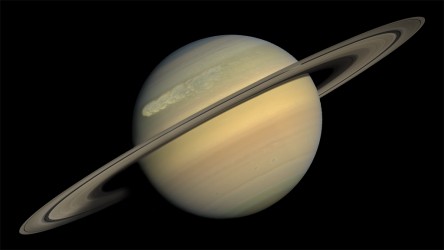
“No [expletive] way!”, the young lady cried. Realizing her faux pas in the middle of a crowd of over 100 people, at a family oriented star party in the middle of one of our most popular state parks, she quickly clamps her hand over her mouth. I can’t help but chuckle at her embarrassment.
Speaking more sotto voce she says, “There’s no way that’s real, it looks like a special effect in a movie!”. I assure her that what she is seeing is indeed real and that it is floating out there in space some 740 million miles away. She takes another look through my telescope and after about a minute or two she steps away, shakes her head and, clearly moved by what she has seen, says, “I had no idea it would look so beautiful or so surreal. Thank you for showing it to me.” She then wanders off into the darkness to look through someone else’s telescope, still somewhat gob smacked by her visual encounter with one of the most majestic objects in our solar system, the planet Saturn. Being able to share something wondrous with others is what makes my little efforts at astronomy and science outreach so worthwhile.
WHEN AND WHERE TO LOOK
Saturn is at opposition on the night of June 14th. This means that the planet lies opposite the Sun in our sky, rises at sunset, remains up all night long, and is at its closest to us for the year. This also means that Saturn will be at its brightest- throughout June it will be shining right around 0 apparent magnitude, very bright indeed- and appears its largest in telescope views. To the naked eye, Saturn appears as a very bright, creamy-yellow “star”.
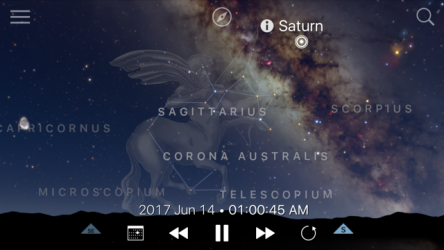
At mid-month, Saturn clears the southeastern horizon right around 9:00 PM but if you want to see it with a telescope then you won’t get a good view until around 1:00 AM CDT when the planet has climbed high enough in our southern sky. Any object viewed through a telescope while it is low in the sky is subject to atmospheric distortion because you are looking through a thicker and hazier layer of atmosphere when gazing off towards the horizon. Unfortunately, Saturn will continue to reach opposition in the southern part of the summer zodiac over the next several years thus keeping it low in our sky. However, those of us here in Arkansas will have it better than, say, folks at higher latitudes where Saturn appears even lower in their skies.
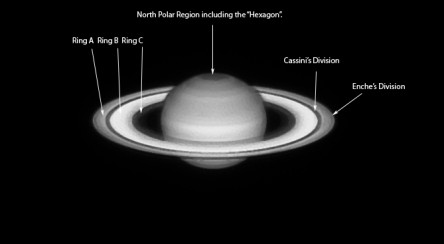
As a consolation prize this year, Saturn’s northern hemisphere summer began back in May which means that the hemisphere is now tilted towards the Sun and thus it’s magnificent ring system is also tilted quite favorably towards us at their maximum angle of 27 degrees. Even a small telescope will easily show both the rings and the major gap within them known as the Cassini Division. If you don’t own a telescope you can now check one out from the Central Arkansas Library System, you can also come to one the Central Arkansas Astronomical Society’s summer star parties and see Saturn that way.
For more information on the library telescopes go here: https://www.cals.org/telescopes/
For a list of CAAS events go here: http://www.caasastro.org
WHAT YOU ARE SEEING
 Composed chiefly of 75% hydrogen and 25% helium, this gas giant is the second largest planet in our solar system family (Jupiter of course is the largest) with a nearly 75,000-mile-wide diameter. It rotates once upon its axis every 11 of our hours and makes a complete trip around the Sun every 30 Earth years.
Composed chiefly of 75% hydrogen and 25% helium, this gas giant is the second largest planet in our solar system family (Jupiter of course is the largest) with a nearly 75,000-mile-wide diameter. It rotates once upon its axis every 11 of our hours and makes a complete trip around the Sun every 30 Earth years.
The gas giant also has a rather low density. Lower even than that of water. And yes, if you could find an ocean of water big enough, Saturn would float on top of it.
Saturn doesn’t have the distinctive cloud bands like those we see with Jupiter but they are there, they are just very subtle. If you could visit Saturn’s cloudy atmosphere you would find that there are three cloud deck levels: one made primarily of ammonia ice, another made of ammonium hydrosulfide, and the third is composed mostly of water clouds. All in all, I suspect Saturn is a bit smelly. Oh, and back in August of 2009 NASA captured the first images of lightning on another planet from a giant storm that churned in Saturn’s atmosphere from January to October of 2009.
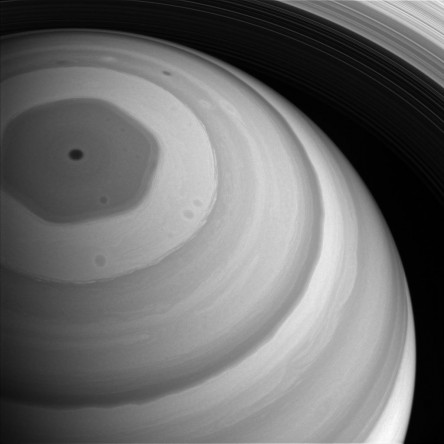 While Jupiter’s winds are measured in hundreds of miles per hour, Saturn can boast being the windiest place in our solar system with wind speeds clocked at a brisk 1,120 mph. One of Saturn’s most bizarre atmospheric features (honestly, I’d rank it high up on any list of the solar system’s most bizarre features) is a 20,000-mile-wide cloud feature at the planet’s north pole. But that’s not the only interesting aspect of this cloud, it’s also shaped like a hexagon.
While Jupiter’s winds are measured in hundreds of miles per hour, Saturn can boast being the windiest place in our solar system with wind speeds clocked at a brisk 1,120 mph. One of Saturn’s most bizarre atmospheric features (honestly, I’d rank it high up on any list of the solar system’s most bizarre features) is a 20,000-mile-wide cloud feature at the planet’s north pole. But that’s not the only interesting aspect of this cloud, it’s also shaped like a hexagon.
I suspect that NASA’s custodial crew put in a lot of overtime just picking up astronomers jaws off the floor when they first discovered it back in 1988 while reviewing data from the Voyager spacecraft flybys of 1980 and 1981. After several decades of intense scrutiny, the Saturn hexagon continues to defy complete explanation. What we do know is that this feature is the work of a polar jet stream, that there is a massive hurricane centered at the north pole with an eye 50 times larger than any seen on Earth, that the hurricane and hexagon spin in a counterclockwise fashion, that there are numerous small vortices inside it, that it has persisted for 30 years (likely longer), and that over the years it has changed color from blue to yellow and that these color changes seem to correspond with the changing Saturnian seasons. Our solar system is constantly surprising and challenging us and this unique atmospheric feature is a prime example of this. Which is fine by me. After all, where would we be without challenges and mysteries to solve? Of course, you cannot see the hexagon with a telescope but it’s cool to know that it’s there while you are observing it.
Saturn’s rings on the other hand are easily within reach of a small telescope (in binoculars the planet just appears as a disc with a bulgy mid-section) and it is the rings that make Saturn the showcase object that is. The rings just seem to be compensating for the fact that Saturn will always be tiny in a backyard telescope view (at best, about 21 arcseconds in diameter: one arcsecond is about the width of a dime seen from 1 ¼ miles away). Pro tip: any attempt at overmagnification of Saturn will leave you with blurry disappointment, so don’t push the limitations of your optics too much.
Over the past few decades we have come to learn that all the outer planets (Jupiter, Saturn, Uranus, and Neptune) have ring systems around them, but Saturn’s is by far the most prominent. The rings are composed of icy particles that range in size from dust grains to chunks as big as mountains. They span some 175,000 miles across but are only about 30 feet thick in some places and 3,200 feet in others. Pretty thin overall, and to give you some perspective try and imagine a model of Saturn that is only three feet across. On such a model the rings would be about 10,000 times thinner than a razor blade. Even a telescope with a modest three- inch aperture will show you that the rings have divisions within them. The largest gap within the rings is the Cassini Division which I mentioned earlier and is named for the Italian astronomer Giovanni Cassini who discovered them in 1675.
Saturn has a diverse array of 62 moons orbiting around it and a small telescope will show you the largest, Titan, as a star-like point when it is visible and not hiding on the other side of the planet. With a large telescope of, say, 10 inches in aperture, you can begin to see a half dozen more. But you might be wondering which moon is which while observing. Well, like with most things in life nowadays, there is an app for that. Yes, there are apps that can show you the positions of the most prominent moons any time of day or night.
Ever since July of 2004 NASA’s Cassini spacecraft (named in honor of the astronomer) has been our robotic representative to the planet Saturn and it has returned to us a wealth of data and images of the planet, its rings, and its many moons. During the past 20 years, some 3,000 research papers have been published utilizing this data and the public has been thrilled with each new discovery and awe inspiring photograph. But all good things must end, as they say, and Cassini’s time is now up. On September 15th of this year, with its fuel spent and its mission at and end, the ever-faithful spacecraft will cast off this mortal coil by plunging into Saturn’s interior. Over the last few months the craft has been undergoing a series of orbital maneuvers taking it ever and ever closer for its final embrace with the planet, all the while returning even more data to make sure we learn as much as we can about Saturn before it reaches the end.
The discoveries Cassini has made are so numerous I could not possibly list them all but here are a few highlights.
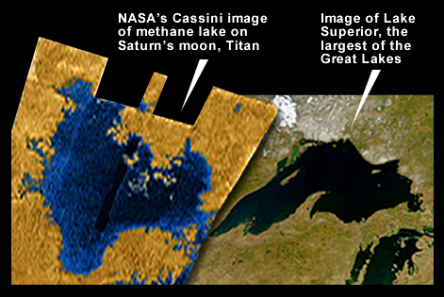 • In 2005 Cassini released its traveling companion, the European Space Agency’s Huygens probe so that it could land on Titan (the craft was named in honor of Christiaan Huygens the 17th century Dutch astronomer who discovered the moon). Huygens, via Cassini, sent back images of a world that looked not unlike that of Earth, especially an Earth as it might have been in its infancy, a pre-biotic Earth. We learned that the atmosphere of Titan is a rich soup of hydrocarbons and that it produces methane rain. In fact, this methane, which is a gas here on Earth but in the extreme cold of Titan’s atmosphere stays a liquid, produces a liquid cycle very much like what we see here on Earth as a water cycle. The liquid methane creates erosion channels on Titan’s surface and even forms large lakes of liquid methane and ethane.
• In 2005 Cassini released its traveling companion, the European Space Agency’s Huygens probe so that it could land on Titan (the craft was named in honor of Christiaan Huygens the 17th century Dutch astronomer who discovered the moon). Huygens, via Cassini, sent back images of a world that looked not unlike that of Earth, especially an Earth as it might have been in its infancy, a pre-biotic Earth. We learned that the atmosphere of Titan is a rich soup of hydrocarbons and that it produces methane rain. In fact, this methane, which is a gas here on Earth but in the extreme cold of Titan’s atmosphere stays a liquid, produces a liquid cycle very much like what we see here on Earth as a water cycle. The liquid methane creates erosion channels on Titan’s surface and even forms large lakes of liquid methane and ethane.
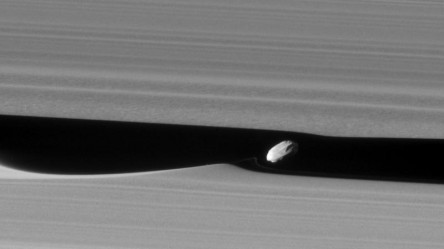 • As the Cassini spacecraft explored the ring system of Saturn in greater detail it discovered several all new tiny moons (most of them only being a few hundred feet in diameter) orbiting within the rings. These little moons probably form from the particles that make up the rings and then go on to carve out the various gaps within the system.
• As the Cassini spacecraft explored the ring system of Saturn in greater detail it discovered several all new tiny moons (most of them only being a few hundred feet in diameter) orbiting within the rings. These little moons probably form from the particles that make up the rings and then go on to carve out the various gaps within the system.
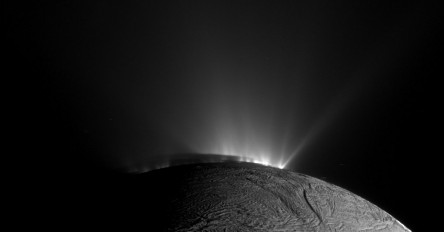 • Saturn’s moon Enceladus may be a good place to look in our search for extraterrestrial life. In 2006, the announcement was made that Cassini had discovered plumes of water ice spurting out from Enceladus and into space (these icy particles in fact add to one of Saturn’s tenuous outer rings), hinting at the existence of a subterranean ocean beneath the moon’s icy exterior. The gravitational pulls and tugs from Saturn and the other moons was heating up the interior of Enceladus and thus creating this liquid ocean beneath the ice. What’s more, this water has the chemical potential to support simple, microbial life.
• Saturn’s moon Enceladus may be a good place to look in our search for extraterrestrial life. In 2006, the announcement was made that Cassini had discovered plumes of water ice spurting out from Enceladus and into space (these icy particles in fact add to one of Saturn’s tenuous outer rings), hinting at the existence of a subterranean ocean beneath the moon’s icy exterior. The gravitational pulls and tugs from Saturn and the other moons was heating up the interior of Enceladus and thus creating this liquid ocean beneath the ice. What’s more, this water has the chemical potential to support simple, microbial life.
So you see, Saturn is more than just another pretty face, it’s complex, it’s deep, it’s mysterious, it has layers. For centuries, we have wondered about its true nature, we’ve gazed longingly at it through our telescopes, we have sent probes as our machine avatars to explore it, and we have learned a lot. But in the process, we have raised even more questions and the answer to one could tell us if life arose only once upon a rock within a quiet corner of the universe or if it happened elsewhere as well. Saturn continues to beguile us with its beauty and wonder and I’m sure that we will return there one day to find the answers to our many questions. And, in the process, to uncover even more questions. To ask questions, to wonder, and to explore is what we do best as human beings, it’s in our very DNA. And you can begin your own adventure of exploring the solar system this summer from your very own backyard. Get outside, look up!